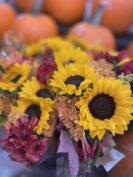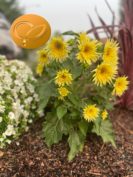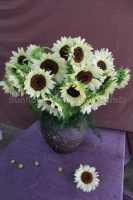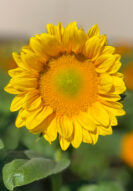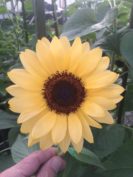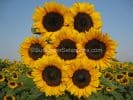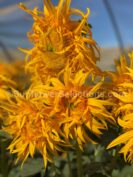Q. Where do your sunflowers come from?
A. We actually develop all of the sunflower varieties that we sell by conventional plant breeding. No genetic engineering, no GMO. It’s a long process that takes at least 7 years from start to finish before we can produce the seeds. We don’t sell any varieties released by other breeders or seed companies. We constantly incorporate new traits into our flowers to bring you novel kinds of sunflowers for your pleasure and to expand the sunflower cut flower opportunities.
Q. When should I plant my sunflowers?
A. Sunflower can be planted over a wide range of planting dates starting in the early spring. A soil temperature of about 50 F (10 C) is required for germination. You should check your local weather data to learn the average date of the last frost in your growing area. If you wait a few weeks beyond that date, you can begin to plant. Seedlings will tolerate a light frost, but more advanced plants are killed by frost. I figure when the trees start to flower and show green, I can begin to plant. And you can continue planting well into summer at least until about 75 days before the first frost. In parts of Southern California and Florida, some growers can plant in the winter months if they are frost free.
Q. Can I save seeds from the varieties sold by SunflowerSelections.com?
A. Most of our sunflower varieties are pollen free. We make them pollen free so that the flowers will last longer in your garden or in a bouquet. It also broadens the appeal of our sunflower varieties since our pollen sensitive customers don’t have to contend with pollen.
The fact that our varieties are pollen free means that they cannot pollinate themselves and therefore will not breed true from any seeds that you might find in heads after flowering. The seeds that you might find are the result of insect pollinators visiting your pollen-free flower and depositing pollen they might carry from other sunflowers in the area. The resultant plants grown from saved seeds taken from pollen free sunflowers are a combination of your planted variety and an unknown pollen donor. They are sunflower mutts. Remember, bees can forage as far as 2 miles (3 km) from the hive so you never know what you will get.
So, the seeds that you save will grow, but the plants will be different than the seeds you buy from SunflowerSelections.com. We hope you will rely on SunflowerSelections.com to supply pure source seeds of our varieties year after year directly from our own breeder!
Q. I plant my sunflower seeds and nothing grows. What do you think is the problem?
A. The biggest problem most people have with planting any seed is they either plant them too shallow or too deep. “Too shallow” means the seeds might imbibe water, swell, and begin to germinate only to have the soil lose moisture. This, of course, causes the developing seedling to die because it, too, dries out. “Too deep” means that the seedling just does not have enough “ooomph” to make it out of the soil. It uses all of its stored energy reserves trying to elongate and push through the soil only to fail before it can reach sunlight and start photosynthesizing. Crusted or compacted soil aggravates the problem and traps the seedling underground where it dies or succumbs to soil pathogens or pests. We always plant our sunflowers less than 2 inches deep (5 cm) for large seeds, and 1 inch (2.5 cm) for smaller seeds.
There are other factors that determine your planting success. Wireworms and other larvae (commonly called grubs) can attack and eat the young seedling underground before emergence. Look for partially eaten seedlings beneath the soil or seeds that look like they have been drilled out!
Once emerged, your seedlings can be mowed down by cutworms, snails and earwigs, for example. Insects like sprouts, too. We use a bit of insect bait around the planting area just to be sure. Finally, watch for birds. When the sunflower seedlings are pushing through the soil, the hulls frequently adhere to the young plants. A bird sees the hull as a seed waiting to be eaten. They peck the seeds and break the stems of the seedling. You might try a length of wire mesh, bent at a right angle and placed over your planting area. Rarely do birds attack sunflower seedlings once they are established.
Q. I grow like to grow your snack variety ” Salt ‘n Roast.” The problem is the birds eat the seeds before they are dry. How can I fight the birds?
A. First, Salt ‘n Roast is an excellent variety to grow if you want to try roasting your own seeds. The seeds are long and well filled. You are right, the birds like sunflower seeds, too. This is especially true in the garden when you have a few isolated plants. Usually, the birds attack the seeds in the ripening heads starting at about 15 days after flowering. At this stage, the kernels are sweet and milky. The birds hang upside down from the edge of the head, or stand on a leaf stem to get at the developing seeds.
The best solution we have found is to cover the head with a bag. You must use a bag that allows air to flow around the head so you don’t promote rot. Likewise, it should be a bag that does not get soaked with water from rain so as to make the plant top heavy and cause it to topple. The only bag we use at SunflowerSelections.com is a netted onion bag. Pull the bag over the flower after flowering and tie it around the neck leaving plenty of loose space for the head to expand as the seeds develop. We have also heard people say that old panty hose or nylon stockings will do the trick.
Q. Should I cut up my sunflower stalks and dig them back into the soil in the fall?
A. It’s nice to think that all those stalks and leaves should be returned to the earth when your gardening season is finished. Ideally, that is the way it is supposed to work. However, you should realize that gardens are dedicated growing areas that are used year after year. Unlike farmers’ fields where crops are rotated, gardeners tend to plant pretty much the same plant species in nearly the same place every gardening season. We are creatures of habit, I suppose. Sometimes our orderly approach to gardening causes plant pathogens to build up in a particular spot in the garden because we supply the same host plant for infection every year. Then we turn around and incorporate the diseased plant material back into the soil! Here is what we recommend. Don’t return diseased plants to the soil where you plan to grow sunflowers the next year. If a plant is diseased, eliminate it from the garden area to be sure. Or compost it and spread the compost in a different area of your landscape. This advice will serve you well for any plant species in your garden, not just sunflower.









